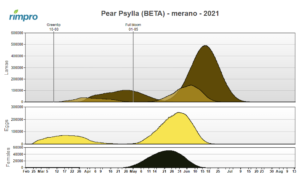Pear Psylla
Pear psyllids secrete large amounts of honeydew. Sooty mold can grow on its surface and develop on shoots, leaves and fruit. The psyllid is also a vector of pear decline (caused by a phytoplasma) which leads to a loss of tree vigour.
Adult pear psyllids are 2-3 mm long and vary in colour from orange to black (depending on the season) with longitudinal stripes. Their forewings are transparent with dark veins. Pear psyllids overwinter in their adult form, taking shelter in the bark of pear trees. The adults become active in spring and start feeding on young leaves and flowers. The first orange-yellow eggs are laid directly on the wood, usually at the base of unopened buds. When foliage becomes available, from mid to late March, oviposition takes place mainly on expanding leaves and flowers. Eggs are laid along the leaf veins, on the stems and sepals of flowers.
There are 5 larval stages that feed on growing leaves and shoots. The summer adults are lighter in colour than the winter adults; depending on the temperature, 3 to 6 generations can develop per year before the adults return to overwintering.
The Model

Only the first 2 generations of psyllids are modelled. From the 3rd generation onwards, all stages are present in the orchard and the different control techniques are less efficient.
The lower graph models the presence of adults.
The middle graph models the number of eggs on the trees. Laying starts when the temperature is favourable and when the day length allows it.
The upper graph models the number of larvaes on the trees. The young stage I larvae are shown separately from stages 2, 3, 4 and 5 which are grouped as “old larvae”. These stage I larvae produce little honeydew and are therefore more sensitive to treatments.
Larvae that are born before bud break die quickly due to lack of food. This parameter is taken into account in the model and this is why it is important to enter your pear green tip stage date.